
Peachy Carnehan
-
Posts
40 -
Joined
-
Last visited
Content Type
Profiles
Forums
Blogs
Gallery
Events
Store
Posts posted by Peachy Carnehan
-
-
The title of this topic should read: Horace Pitt Kennedy Skipton - Indian Police Service. It seems one can edit the body of a post but not the title once it is posted.
0 -
Here is a cabinet photograph from my collection that is also posted on my website.

This photograph is inscribed on the reverse simply "Horace Skipton May 89" and identifying this photograph proved to be something of a mystery. I first assumed that he was a member of a rifle battalion but I was unable to find anyone by that name mentioned in the Army Lists serving in either the British or Indian armies for several years either before or after the date on the photograph.
As it turns out this man is in all likelihood Horace Pitt Kennedy Skipton who was member of the Indian Police Service from 1883 to 1899. While his uniform does indeed resemble that of a rifle battalion his being a member of the Indian Police Service would explain finding no mention of an officer by this name in the Army Lists.
According to the India List, Civil and Military for January 1888 Skipton was Director Superintendent of Police, 5th Class for Bilaspur.
After leaving the Indian Police Skipton returned to England and served in several high ranking positions in the clergy. He was the editor of several publications relating to the church and India as well as the author of several books on the same subjects.
Skipton was born in 1861 in Warwickshire, the son of Daniel Pitt Kennedy Skipton. He married Jessie Goodwin in 1890 and had a daughter named Gertrude and a son named Gervais. He died on 16 February, 1943.
0 -
Here are some scans of the attestation and records papers for 1977 William Thake, 88th Regiment of Foot/ 1st Battalion, The Connaught Rangers.
He mustered in 15 December, 1873 at the age of 14, 4 1/2 feet tall with a listed trade of musician so he was a drummer boy literally. He rose through the ranks eventually reaching Canteen Sergeant in 1888. His overseas service included India and South Africa (Zulu War, South Africa Medal with 1877-8-9 clasp) and earned the Long Service and Good Conduct Medal (I posted a scan of his LS&GC on the Biritsh Medals section of this forum a few weeks ago. He was discharged for medical reasons (hepatitis) on 5 April 1894 with over 21 years of service under his belt.
The 1901 census lists Thake living in Stepney, Middlesex, England with his wife Amy (who is also listed in his papers as with the regiment) and two children - Cyril and Muriel. His occupation is listed as an Inspector of Customs.
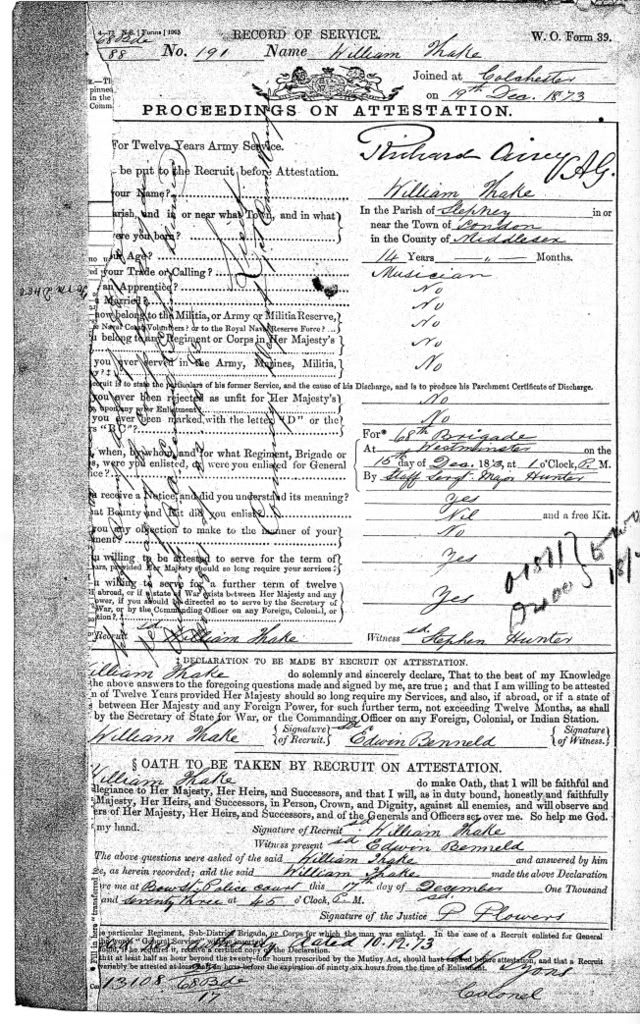
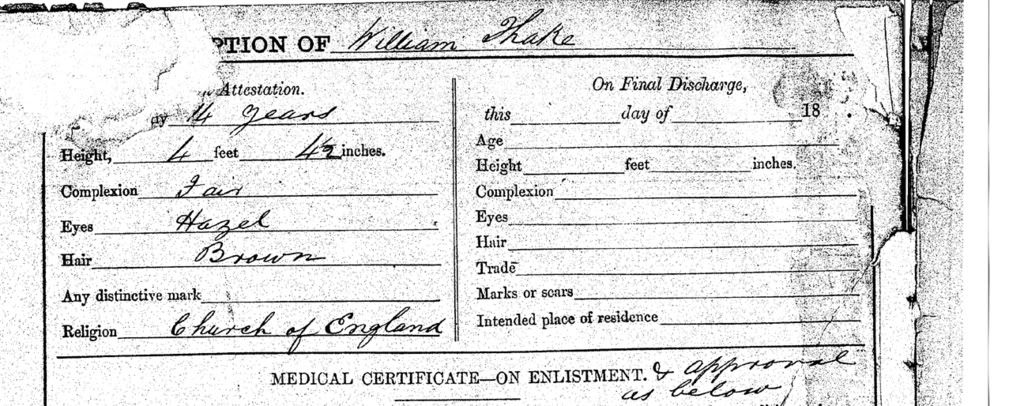
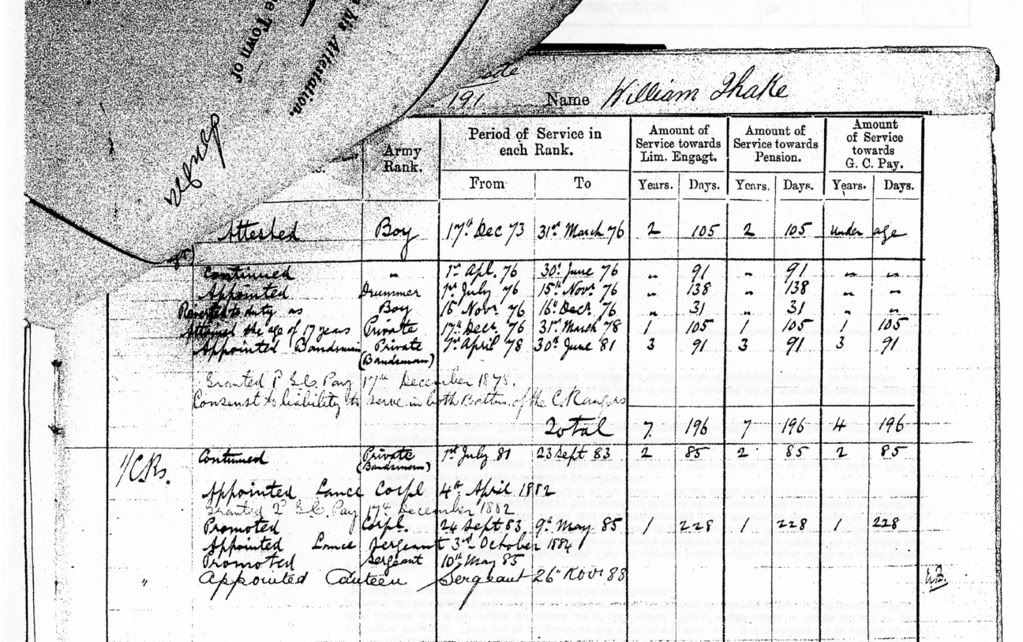 0
0 -
Here is the other photograph I mentioned. It is in poor condition but never the less offers a rare glimpse into an obscure subject:

Quite obviously a posed photo it shows two memebers of the Nongqai who have just "arrested" what could be a British soldier. He in shirt sleeves and still wears a bayonet on his right hip. The photograph also appears to have been taken on board a large ship.
0 -
Hi Peachy
That is a very interesting photograph. Are the men actually identified as belonging to the Zululand Police? The only ZP photos I have seen illustrate three articles on the history of the ZP published in the Natal Police magazine (appropriately named 'The Nongqai') and they are not nearly as clear as yours. However, there are some observable differences, such as the men wearing side-caps and having tunics opening all the way down the front with 5 or 6 buttons. Also, it is unusual that the 'other rank' carries an assegai. As far as I know the ZP were armed with rifles, which were very necessary for their Zululand policing and during the Boer War (1899-1902) and Natal Rebellion (1906).
I agree that the young officer is not Mansel. In fact, he looks much younger than the +/- 15 officers shown in the ZP articles, all of whom have (some very impressive) moustaches. (This is also a feature of men in the Natal Mounted Police/Natal Police and it was clearly fashionable in late Victorian/Edwardian times.)
Hi Brian
I suspect that your assegai might be of 'European' manufacture and of the type issued to men of the Native Military Corps during World War II. It looks as though it has a hollow base into which the shaft would have been inserted. This is not Zulu technology. Zulu assegais had pointed tangs, which were heated and burnt into the shafts and then fixed in position by wound wire, plaited reeds or a section of oxtail skin. I was once told that the last method, which involved stretching the tail section over the tang/shaft joint and then allowing it to dry and shrink, died out after the Zulu War. I have a throwing assegai of this kind that was confiscated by police after a faction fight in Zululand in the 1950's.
Regards
Brett
I have another Boer War vinatge image of two members of the Nongqai "arresting" a Biritsh soldier. They are both dressed as you stated above. My best guess to date regarding my above shown photograph is that it was taken very close to the establishment date of the Nongqai sometime around 1883. This might explain the variation in uniform etc. I believe I have also seen members of this police force wearing blue cloth helmets similar to the British Home Service Helmet.
0 -
Another excellent photo Peachy, thank you. Am I right in thinking that you are responsible for the excellent online museum, Soldiers of the Queen?
You found me out! :D
0 -
from my collection:

Above: A c. 1895 cabinet photograph of a very young member of the Royal Fusiliers, City of London Regiment.

Above: a carte de visite of a young bandsman from the rifle volunteers c. 1880. Possibly the Somerset Rifle Volunteers.
0 -
This has got to be my favorite tank, if for no other reason than it's incredible wierdness.
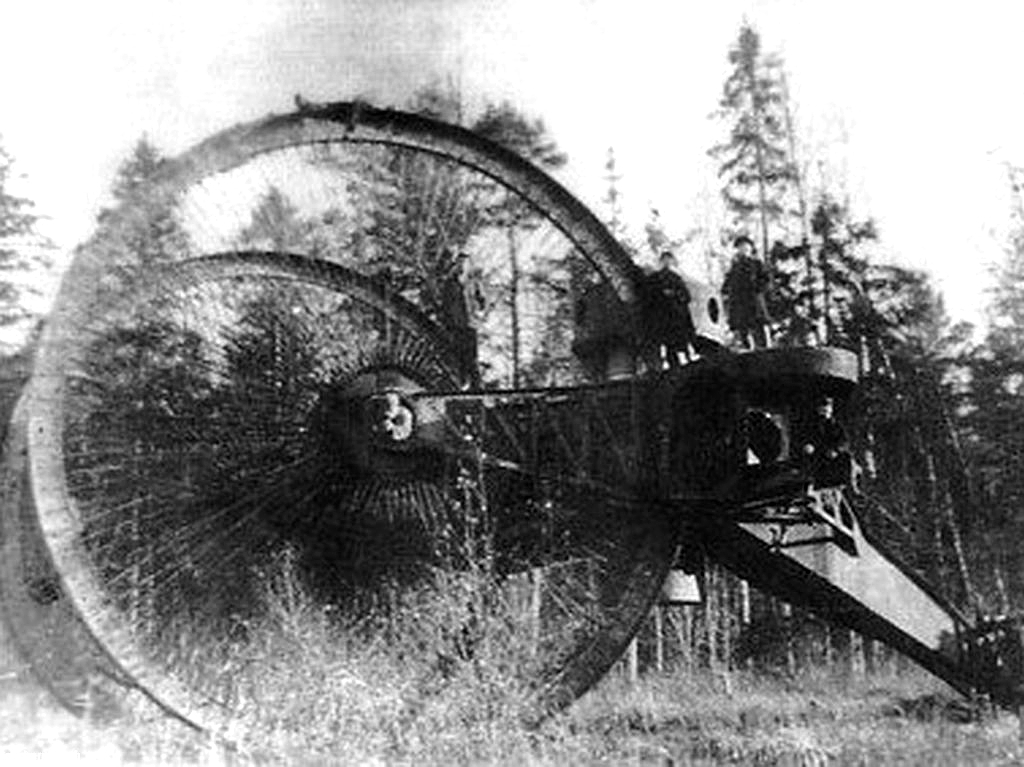
The "Tsar Tank" from Russia c. 1915. Needless to say the design was not widely adopted by many armies.
0 -
That second photo puzzles me. He is wearing TWO cap cockades, which was not correct for Imperial troops, who only wore the tricolor on their cap band.
I have seen such double cockades referenced at:
0 -
Here are a few German colonial cabinet photos from my collection
The first image shows two German privates of the 1st Regiment, Deutche ?stliche Asiatiche Brigade. Both men wear what may be the German medal for the Boxer Rebellion. Both men are armed with the Mauser K-98 rifle.

The next image shows what I believe to be a member of one of Imperial Germany's Seebattalions that were roughly equivalent to the United States Marine Corps and the Royal Marines. He appears to be wearing a uniform intended for overseas deployment. The hat with its cloth neck protector would tend to indicate a tropical station. The bold "Auf Wiedersehen!" title on the card mount implies that the photograph was taken just prior to this man shipping out to his overseas posting, possibly the Boxer Rebellion in China (1900).

The third image shows a German private was a member of the Kaiser's Schutztruppen for German South-west Africa - Schutztruppe f?r Deutsch S?dwest Afrika. The reverse of the photograph originally had this soldier's full name and address written on it but the photographer pasted his label on top of the pertinent information. All that can be determined is the soldier's last name of Finke and that he may have lived in Wilhelmshaven.
 0
0 -
Here is an overall view of one of Fort De Soto's mortar batteries - I don't remember which. Originally there would have been four mortars in this emplacemnet but as I mention above two mortars were moved.
I am also attaching a current photogragh (not mine) of Battery Way on Corregidor for comparison.
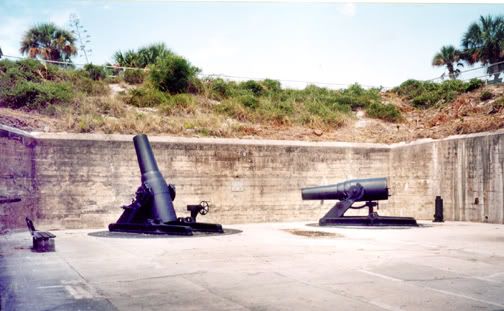
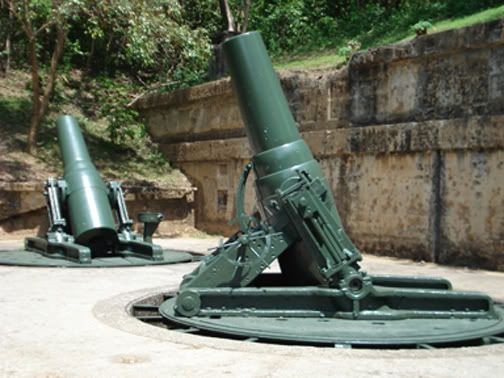
What I find surprising is that these two mortars on Corregidor are in better shape and more complete -even after going through World War II - than are ther counterparts on Mullet Key.
0 -
The bore on these is 12 inches so a small kid could fit inside - they covered the muzzle and breech with plexiglas to keep anyone from getting stuck.
Missing from the mortars are the recoil mechanisms. These are there is storage but for some reason were removed and are now pretty rusty. I don't think it would be very hard to restore them with a bit of sand blasting and black paint. They would certainly add a lot to the look of these vintage guns.
Here are two more pictures I dug up. Both were taken during the same trip. These show the two M-1898 6-inch rapid fire Armstrong guns that were brougth to Fort De Soto from Battery Burchstead, Fort Dade on Edgmont Key in 1980 after that battery collapsed into the sea. They have been partially restored but up close they are heavily pitted from decades of exposure to the sea. The guy in the picture with the ice cream cone in my co-worker Curtis who I think was fantasizing about something when I snapped that shot.
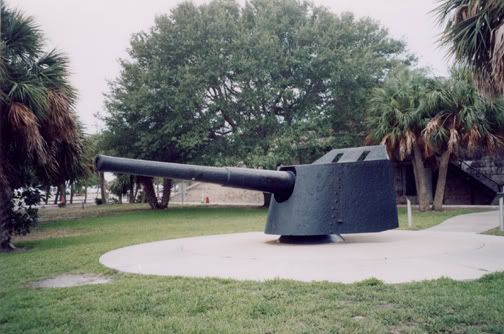
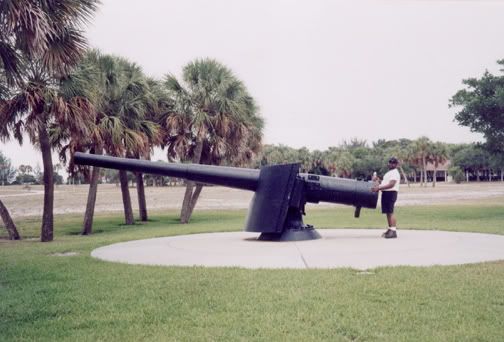 0
0 -
Here are a few shots taken at Fort De Soto located on Mullet Key in Tampa Bay, Florida.
The guns shown are tow of the four remaining 12-Inch seacoast rifled mortars still implaced at the fort which was built soon after the Spanish-American War. There were originally eight mortars in two four gun batteries at the fort. Four mortars were moved to fortifications in San Diego, California and later I believe these same for mortars ended up on Corregidor Island in Manila Bay.
The first pic shows me next to one of these 13-ton M1890-M1 beauties. The other two are detail shots.
Anytime you may find yourself down around Tampa Bay the fort is well worth a visit.
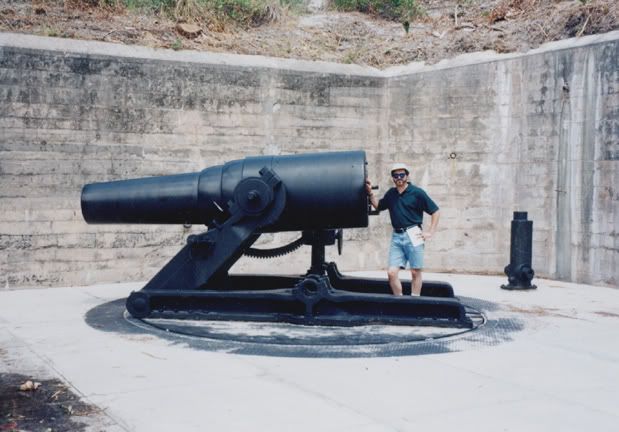
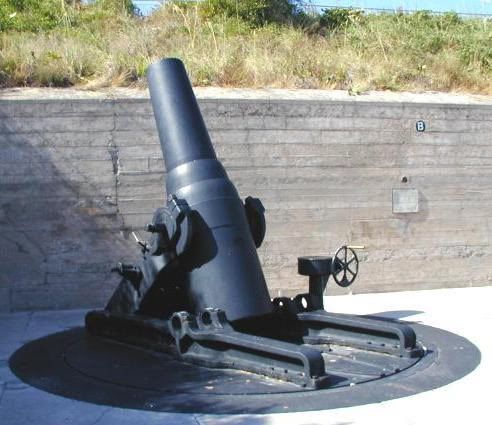
 0
0 -
I looked orver the criteria for the Purple Heart and can fine no reason why it could not be awarded to a non-U.S. soldier. It seem that the emphasis is on while a soldier is wounded or killed servinving with U.S. forces against an armed enemey.
Here is the section fo the criteria that seems to apply:
3. Criteria: a. The Purple Heart is awarded in the name of the President of the United States to any member of an Armed Force who, while serving with the U.S. Armed Services after 5 April 1917, has been wounded or killed, or who has died or may hereafter die after being wounded;
(1) In any action against an enemy of the United States;
(2) In any action with an opposing armed force of a foreign country in which the Armed Forces of the United States are or have been engaged;
(3) While serving with friendly foreign forces engaged in an armed conflict against an opposing armed force in which the United States is not a belligerent party;
(4) As a result of an act of any such enemy of opposing armed forces;
(5) As the result of an act of any hostile foreign force;
....
The emphasis is mine but you will notice it never states that a recipient must be a member of the U.S. armed forces but only serving with the U.S. armed forces in combat with an enemy.
Looking at the two photos of the Dutch veterans I notice that both are wearing the CIB. This would seem to confirm that they did indeed serve with and as part of U.S. forces even if they were still members of the Netherland's military.
Here is the relative section of the Soldier's Medal Criteria:
The Soldier's Medal is awarded to any person of the Armed Forces of the United States or of a friendly foreign nation who, while serving in any capacity with the Army of the United States, distinguished himself or herself by heroism not involving actual conflict with an enemy." (Army Regulation 600-8-22).
Again the emphasis is mine but the regs are quite clear.
0 -
One other small detail. The fake at the beginning of this thread had its wire connecting rings welded or soldered closed. The apparent real ones picutered were left with plain butted ends. Go figure.
0 -
I have never understood why they have to have holes drilled through the medal to connect it to the suspender. It makes the whole thing look like a bit of an afterthought. They don't even do this with the Army rifle qualification badges. This makes me feel much the same way as them using plastic on the current Purple Heart instead of the original enamel. Is it to expensive to do it right? What is the sacrifice the men who have earned these medals worth after all?
0 -
Hallo Gents,

just a quick question, do you know where its possible to locate a full size neck ribbon
for the WW1 MOH, its for a legitimate cause, as a replacement for a museum piece here in Romania.
Or who to approach to source one officialy.
Kevin in Deva.

I don't beleive that it is illegal (in the U.S.) to sell the MOH ribbon or replicas threreof. So I doubt - unless you are the original presentee - to get a replacment ribbon from the U.S. manufacturer. Anyone feel free to correct this if I am worng here. A museum may be able to get such a ribbon but I have a feeling that an overseas organization may find it difficult if not impossible to get the real thing.
0 -
Here is another cabinet photograph from my collection.

The photograph shows an armed memebr of the Nongqai or Zulu Police with a seated white officer - possibly a Sub-Inspector or Inspector - of that same force. The Zulu constable is armed with both a Knobkerry (Zulu war club) and a broad bladed stabbing assigai. Interestingly the white officer's walking out or swagger stick is in the shape of a miniature version of the full sized knobkerry carried by the Zulu constable.
I have guessed that the officer could be George Mansel (or Mansell depending on the source) of the Natal Mounted Police who became Commandant of the Zulu Police in 1883 when the former force was organized. This man is not wearing the 1877-79 South Africa Medal which Mansell would have been entitled to so it seems more likely that this man is another person.
0 -
Here is a rather funny if not odd photograph from my collection:

Taken in Rawalpindi India c. 1895 this photograph shows A/Corporal Bugler W. E. Govier standing next to Lt. Col. The Honorable M. Curzon of the 4th Battalion, The Rifle Brigade. Govier stood four feet, nine inches tall while his officer stood six foot, four inches. The photograph was cut from an album.
0 -
Here are two medals in my collection both relating to the Anglo-Zulu War of 1879.
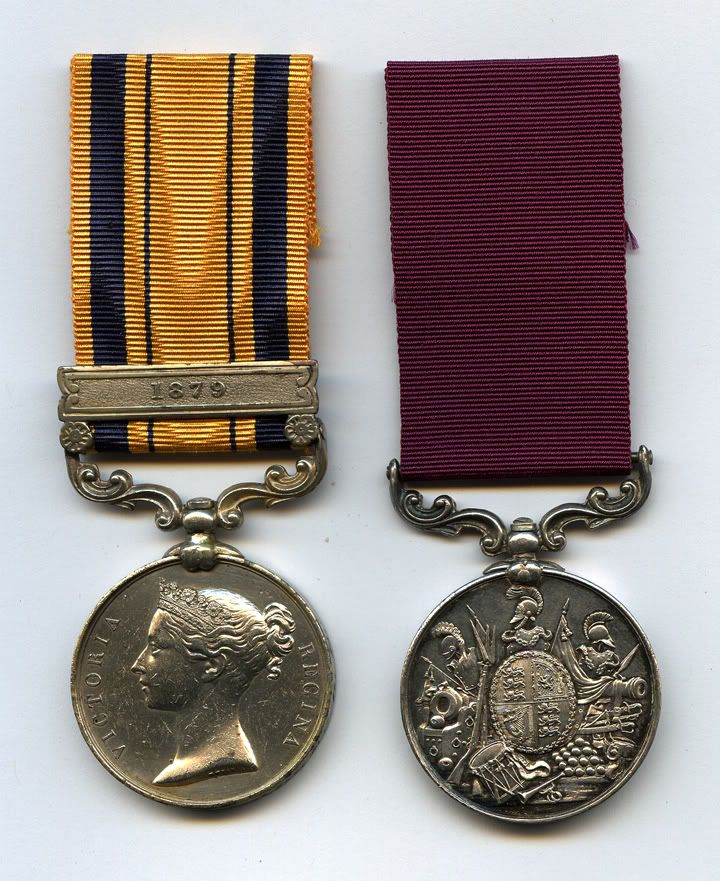
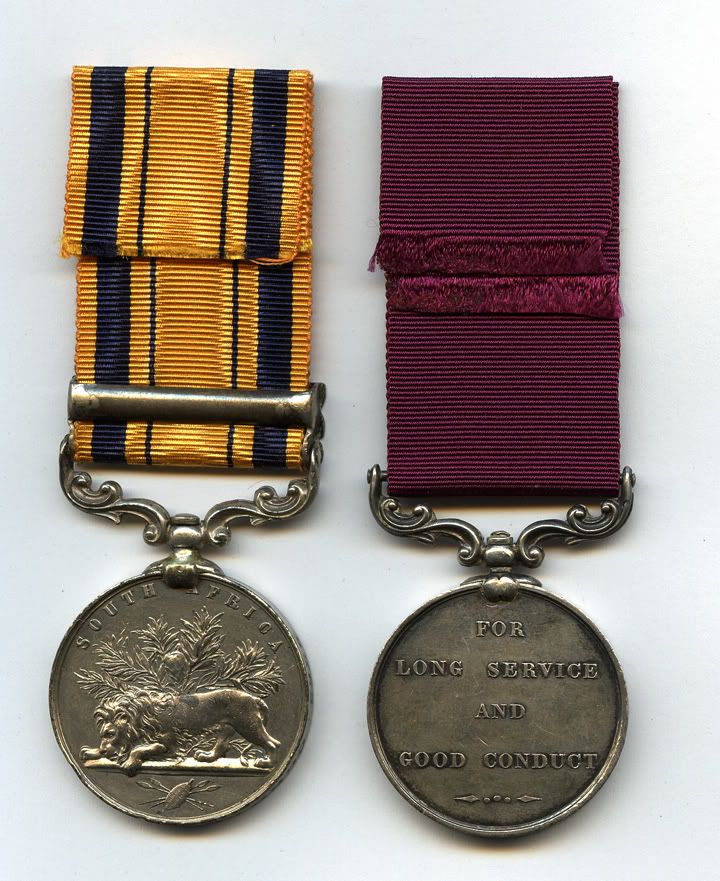
The first medal on the left is the South Africa Medal of 1877-79. This medal was issued to 9265 Corporal J. Clarke of the Royal Engineers. I have been unable to uncover much about Corporal Clarke. It seems that his records were amongst those destroyed by the Germans during World War II. I have found out based upon the South Africa Medal roll that his first name was Josiah and that he served with 30th Co. Royal Engineers during the war. 30th Co. was attached to the 1st Division under Major-General H. H. Crealock during the second invasion of Zululand.
The second medal on the left is Army Long Service & Good Conduct Medal (2nd Type) issued to Sergeant William Thake of the 88th Foot/1st Batt. The Connaught Rangers.
Thake was born in London and enlisted in the 88th when he was 14 years old on 17 December, 1873. He was described as being four feet four and one half inches tall with a fair complexion, hazel eyes and brown hair with a former trade of musician listed.
His postings included home service from December 1873 to June 1877. The Cape (South Africa) from June 1877 to October 1879. India from October 1879 to December 1890. Aden 1890 ? 1891, Home 1891 to 1894.
His first listed rank was that of "Boy" He was appointed Drummer in July 1876, Private ? December 1876, Bandsman ? April 1878, Lance Corporal ? April 1882, Corporal - September 1883, Lance Sergeant ? October 1884, Sergeant ? May 1885, Canteen Sergeant ? November 1888.
During his years as a soldier he was afflicted with many of the usual maladies that beset soldiers on active service in places like South Africa and India. These included ague, conjunctivitis, malaria, rheumatism and gonorrhea and a bout with hepatitis. It was this last disease that ended his military career when he was listed as unfit for further military service in April 1894.
Besides the Long Service & Good Conduct Medal Thake was entitled to the South Africa Medal with the 1877-8-9 clasp for service in both the 9th Cape Frontier War and the Anglo-Zulu war.
Thake was married to Miss Amy Young on 8 June, 1892 and had at least two children, both daughters: Evelyn Mary born in 1893 and Muriel Digby born in 1894.
0 -
Here is a photo from my collection taken in Ireland around 1900 or so. While it does not show the kit laid out for inspection it does show how a soldier was expected the keep his equipment organized. It also illustrates the kind of personal belongings that a typical soldier might have around his bunk.
 0
0 -
Yes I agree - Army Service Corps. I have several similar photos in my collection.
0 -
The photo below is about as non descript an image of a Victorian British militray subject as one might find. It is one of my very early acquisitions and today I would probably not even give it second glance if I saw it for sale. I bought it on eBay quite a few years ago and the seller posted a scan of the front of the photo and offered very little in the way of description. I bought it and much to my surprise someone had penciled on the reverse a very long time ago: "pte. Capper, R.M.L.I, drowned at Alexandria 1882". With this I reaserched Capper's service record as well as the log of the H.M.S. Inconstant and came up with a nice little trove of information which follows below.

George Capper was born in Gloucester on 8 August, 1860 and enlisted for 12 years in the Royal Marine Light Infantry on 8 July, 1879, Capper was described as being 5ft 6-3/4 inches tall with a sallow complexion, dark brown hair and hazel eyes. He served at the Recruit Depot at Walmer from 8 July, 1879 until 24 March, 1880 when he was transferred to the Portsmouth Division. In August of 1880 he joined the ships company of the HMS Inconstant. At is time his character was described as being exemplary. During his tenure aboard the Inconstant Capper's exemplary character seems to have lapsed and his name appeared 6 times in the Company Defaulters Book. His offences included not moving smartly enough at all hands on deck, sleeping at his post when on sentry, neglect of duty while on sentry, having a bottle of grog concealed on him which he intended to give to a prisoner over whom he was about to placed as sentry, dropping his valise brace into the furnace room and leaving his work. For these offences he served 43 days punishment with 14 of those in the cells.
The Inconstant set sail on 17 October, 1880 on a voyage of two years and one that Capper would not return from. The Inconstant sailed in convoy with the Cleopatra, Bacchante, Carysfort and Tourmaline, for Vigo in Spain, then onto Madeira, to St Vincent and down to Montevideo. The convoy arrived at Montevideo on 22nd December 1880 and sailed to Stanley in the Falkland Islands and then to the Cape of Good Hope arriving Thursday 17th February 1881. She stayed in the Cape for two months replenishing coal stocks and exchanging official visits with the British Governor.
The Inconstant and the convoy set sail on 10th April 1881 for Australia. Her first stop in Australia was at Melbourne, where on 23rd May 1881 the ship was 'dressed' and a Royal salute was fired to celebrate the birthday of HM Queen Victoria, this was repeated on Monday 20th June to celebrate her ascension. From Melbourne they went to Sydney. From Sydney the Inconstant sailed to Brisbane, then on to Fiji, Yokohama, Kobe, Simorio, Wusury, Chausan Islands, Hong Kong and back to the Cape of Good Hope.
After a month at the Cape she sailed for St Helena then to St Vincent, onto Gibraltar, to Malta, Limosal in Cyprus and then to Alexandria, Egypt arriving 20th July 1882.
While in Alexandria Capper was part of the British force under Admiral Seymour that was sent to quell the anti-European riots that followed Arabi Pasha's rebellion against the Egyptian Khedive. Although not stated in Capper's service records it would seem that the unfortunate private would have been entitled to the Egypt Medal with the clasp "Alexandria" as well as the Khedive's Star. It could be that Capper having died before the creation and issuance of the said medals he was simply forgotten when the medal rolls where compiled.
The Ship's log of the HMS Inconstant states that Capper jumped overboard early in the morning of 22 September, 1882 while in a state of delirium and was drowned. Divers recovered his body around 9:00 AM and at 9:15 the ship's company was mustered by divisions for prayers in Capper's memory. He was buried at Alexandria. The cause of his delirium is unknown but it may have been due to malaria.

Capper's ship the HMS Inconstant in a photograph taken sometime around 1870. The Inconstant was built by John Penn & Sons and launched on 12 November 1868 as an iron-hulled unarmored frigate of 16 guns that displaced 5780 tons.
Commanded from her commissioning by Captain Elphonstone D'Oyly D'Auvergne Alpin until 13 September 1870. She was later under the command of Captain Lord Walter Talbot Kerr and served as Vice Admiral Frederick Beauchamp Padget Seymour's flagship in the Mediterranean.
The Inconstant survived until 1956 when her remains were scrapped.
I have been anable to find out anything regarding Capper's life prior to his enlistment.
0 -
These pinned on chevrons and insignia almost always appear on photographs taken in tropical climates - India, Burma, Egypt etc. I have never seen this pracitce showing up in "Home Service" photographs taken on Britain.
0


Hoarce Pitt Kennedy Skipton -Indian Police Service
in Great Britain: Mervyn Mitton's British & Colonial Police Forces
Posted · Edited by Peachy Carnehan
Hugh,
I have no idea what those silk robbons/loops may have been called. I even consulted my copy of the British Dress Regulations for 1900 and it makes no reference to an actual name other than "loops of 2/3 inch black braid" describing similar decorations on the frock coats of the Household Cavalry. As to their possible origin again I am not sure but can assume with soem probilility that theydid have some functional origin at one point in time.